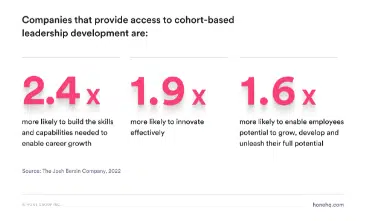What is a Leadership Coach?
The definition of a leadership coach refers to someone who provides guidance, support, and feedback to individuals looking to develop their leadership skills and become more effective leaders. Leadership coaches can work with individuals at all levels of an organization, from entry-level employees to senior executives.
The role of a leadership coach is to help individuals identify their strengths and areas for development, set goals, and create a plan to achieve those goals. In addition, they can guide a range of leadership topics, including communication, delegation, conflict resolution, decision-making, and more. They can also help individuals develop emotional intelligence, an essential component of effective leadership.
Leadership coaches can work with individuals 1-on-1 or in group coaching sessions. They can provide feedback and support through various channels, including in-person meetings, phone calls, email, or video conferencing. Effective leadership coaching can have many benefits for individuals and organizations. It can help individuals develop the skills and confidence they need to be influential leaders and help organizations create a culture of effective leadership at all levels.
Organizational leaders may find that conventional management styles are no longer enough. A coach can teach new management techniques for optimizing corporate performance and employee engagement. In addition, coaches help leaders take newly developed action plans, mindsets, and skills into the future.
What is Leadership Coaching?
Leadership coaching is one of the most effective development tools available. It makes leadership teams more successful and sustainable.
The following are some benefits of leadership coaching:
- Creates and expands self-awareness
- Helps drive transformational change
- Increases retention and decreases turnover
- Quickly aligns new leadership with current strategies
- Reinvigorates current leaders
- Provides critical support
- Improves interpersonal communication and listening capabilities
Leadership coaching enhances the abilities of executives within organizations. Coaching helps leaders mediate workplace behaviors and support project success. In addition, it prepares them for transition and growth to deliver positive long-term results.
Effective managers lead teams through burnout, change, and economic disturbances. Successful organizations invest in training and coaching opportunities. Therefore, their leadership teams can provide transformational guidance during difficult times.
Yet all employees can benefit from leadership coaching. Coaching teaches employees conflict resolution and goal setting. In addition, they can learn how their talents align with their career goals.
How Does Leadership Coaching Help Leaders Perform Better?
Coaching is a solution for leaders, managers, and top-performing employees with high potential. Professional coaching involves a strategic and scalable approach. Therefore, programs usually have a step-by-step process:
- Organizational leaders and coaches establish goals and define objectives during the initial consultation.
- Coaches gather and assess the leadership teams’ histories and trajectories. In addition, they collect data related to the industry, organizational culture, and strategies.
- Coaches debrief the data to organizational leaders. This phase allows them to show how to address weaknesses and leverage strengths.
- 1-on-1 or group leadership coaching installs action plans to achieve desired results.
Leadership teams can receive cohort-based coaching services live or online. Besides classroom learning, participants can reinforce their knowledge with other integrated tools and resources.
Tracking coaching progress is part of measuring its return on value. Smart coaching techniques have measurable results. For instance, organizational leaders can access post-program assessment reports for date-backed insight.
Leadership Coaching Topics
Leadership coaching programs are diverse and expansive. Programs can focus on performance, behavior, and strategy.
The following are some leadership coaching essentials:
- Build High-Trust Relationships
- Give Feedback That Lands
- Lead Highly Effective 1-1s
- Manage Time
- Delegate Work
- Run an Effective Meeting
- Run an Effective Interview
- Have an Effective Remote Work Setup
- Develop an Affective Team Strategy and Plan
- Influence Without Authority
- Lead with Grit
- Manage Bias in the Workplace
- Manage Remote Teams
In addition to teaching management prerequisites, coaches can cultivate a collaborative workplace culture. Learning tracks are a new way to fuel growth. Therefore, coaching is beneficial throughout the employee lifecycle.
How Does Leadership Coaching Help Companies?
Organizational performance measures a company’s output compared to its objectives. Leadership coaching can improve a business’s performance by sharpening skills and behaviors. In addition, coaches finesse collaborative solution-building and develop success resources.
Coaches teach leaders how to set qualitative and quantitative goals. Goal setting helps strategically move teams forward. For instance, objective and critical results (OKRs) help teams set better goals. OKRs can be at the company, department, or individual levels.
Business coaching prioritizes producing desired outcomes. It is ideal when traditional approaches stall the workforce’s performance. These programs create institutional changes that have long-term results.
Behavioral coaching shifts leaders’ mindsets to transform their behavioral patterns. It develops and sustains more cooperative atmospheres by altering attitudes and habits. In turn, leaders’ teams also experience behavioral changes.
Strategic coaching emphasizes overcoming current or future challenges and obstacles. It analyzes comprehensive approaches and leadership methodology. These programs ensure that participants are on the same page and can transform and future-proof the company.
Leadership Coach vs. Executive Coach
Executive and leadership coaches perform similar roles but have some subtle differences. For one, a leadership coach helps employees at all levels. Executive coaches work with C-suite executives or other upper-management decision-makers 1-on-1.
Behavior change is the goal of most executive coaching. But, there’s a surge of benefits for high-profile professionals.
Executive coaching offers professional development for current leaders to improve their management skills. As a result, leaders can improve emotional intelligence, enhance strategic thinking, and promote engagement.
Coaches strive to improve organizational leaders’ performance. They help leaders learn how to better work with, guide, and lead others. Much of the focus is on navigating business relationships to push organizations to tremendous success.
Leaders may need a coach to discuss ideas. Coaches listen to executives to offer a neutral viewpoint. The coach focuses on the client’s professional and personal success, such as:
- Working through decision-making.
- Gaining more awareness about how to reach their goals.
- Personal improvement.
- Improve motivation.
Coaches are often not direct employees of the organization. Instead, external professionals give unbiased support because they do not have a vested interest.
Executive coaching is based on the coach’s background. For instance, they may tailor sessions around management, organizational behavior, or psychology.
What is Cohort-Based Leadership Training?
Cohort-based leadership training is a leadership development program where a group of individuals are brought together to participate in a program or course, usually over several weeks or months. These individuals, or “cohorts,” typically share a common goal or interest in developing their leadership skills and are selected to participate in the program based on their potential for leadership.
Cohort-based leadership training programs can take many forms, including online courses, in-person workshops, or a combination. The program is usually led by a facilitator or instructor who provides guidance, feedback, and support to the participants as they work through the program together.
One of the critical features of cohort-based leadership training is the emphasis on collaboration and peer learning. Participants work together to solve problems, share experiences and insights, and provide feedback and support to one another. This collaborative approach can be particularly effective in developing leadership skills, as it allows individuals to learn from the experiences of others and to practice their leadership skills in a supportive and collaborative environment.
Cohort-based leadership training programs can also provide a sense of community and connection among participants. As they work through the program together, participants can develop relationships and networks that can provide ongoing support and encouragement as they continue to develop their leadership skills.
The Challenges of Traditional Leadership Programs
Traditional leadership development programs can face several challenges and problems that can limit their effectiveness. Some of these challenges and problems include:
- Lack of individualization: Traditional leadership development programs often provide a one-size-fits-all approach, which may not address individual leaders’ specific needs and goals. This can limit the program’s impact and make it difficult for leaders to apply what they have learned to their own unique situations.
- Inadequate support: Many traditional leadership development programs provide training or workshops but do not provide ongoing support or follow-up to help leaders apply what they have learned. This can limit the program’s effectiveness and make it difficult for leaders to sustain their changes.
- Limited focus on practical skills: Traditional leadership development programs may focus too much on theory and not enough on practical skills and strategies that leaders can apply daily. This can limit the program’s impact and make it difficult for leaders to see tangible results.
- Lack of alignment with organizational goals: Traditional leadership development programs may not align with the organization’s strategic goals and priorities. This can limit the program’s impact and make it difficult for leaders to see how their development is connected to the organization’s success.
- Resistance to change: Traditional leadership development programs may face opposition from leaders who are not open to change or who do not see the value in developing their leadership skills. This can limit the program’s effectiveness and make it challenging to create a culture of effective leadership within the organization.
Leadership Coaching Takeaways
To overcome these challenges and problems, organizations may need to rethink their approach to leadership development and consider more innovative and personalized solutions that address the specific needs and goals of individual leaders, provide ongoing support and follow-up, focus on practical skills and strategies, and align with the strategic goals and priorities of the organization. As such, cohort-based leadership training is a powerful tool for developing leadership skills and creating a culture of effective leadership within an organization. By bringing together a group of individuals who are committed to developing their leadership skills, and providing them with the support, feedback, and resources they need to succeed, cohort-based leadership training programs can help organizations develop the leaders they need to achieve their strategic goals and objectives.













